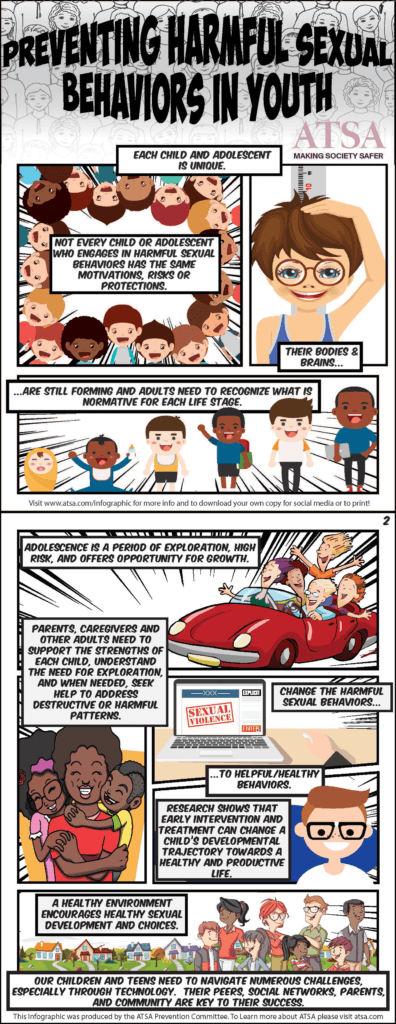5 Things: Preventing Harmful Sexual Behaviors in Youth
At the Association for the Treatment of Sexual Abusers (ATSA) Conference this week in Kansas City, all participants received an infographic on five things to do to prevent harmful sexual behaviors in youth. This infographic was developed by ATSA’s prevention team (of which I am a member.). Click here to get a copy.

Here are the five things to do and additional text from ATSA:
Each child and adolescent is a unique individual
Children and adolescents who engage in harmful sexual behaviors have different motivations, risks, and protective factors as they face different risks, they have different histories, and therefore their need for support systems will be different. A one size fits all intervention will not work for every child and teen. Our responses and support must be individualized for each child.
Children and adolescents are still developing
Children and teen’s bodies and brains are still forming and this continues into early adulthood. To ensure the safety of our children and the development of healthy relationships and sexuality, adults need to understand what is normative and expected sexual development for each life stage. Parents, caretakers, and other adults need training to understand these differences, learn what is usual for each developmental stage, and be involved in a child’s care, growth and treatment, if needed.
Adolescence is a period of exploration, risk, and great opportunity for positive growth
Adolescence is a critical period to identify and understand a youth’s strengths and vulnerabilities. There can also be a mismatch between their judgment and impulse control. Parents, caregivers, and other adults need to support the strengths of each child and teenager, understand their need for healthy exploration–and when necessary, seek help to provide education, develop limit-setting skills, and even provide treatment, to address destructive or harmful patterns of behavior.
Change the harmful to helpful and healthy sexual behaviors
Research shows that prevention, early intervention, and treatment can guide a child or teen’s developmental trajectory towards a safe, productive life with healthy relationships. Early education and support can establish constructive skills and minimize unhealthy patterns of behavior. Every child needs to know their body and sexuality is under their control. No one has the right to force or trick them into any type of sexual behavior. Likewise, they also need to learn that they don’t have the right to force or trick others. Early interventions and support, when problematic sexual behaviors begin to emerge, can be a second opportunity to create a positive path before behaviors escalate into a reportable offense.
A healthy environment encourages healthy sexual development and choices
Our children and teens need to navigate a huge number of healthy sexual developmentally related challenges, especially in their use of technology. It is important to help them remember that they are not navigating these challenges on their own. Their peers, social networks, schools, parents, involved professionals, and community can be the key to their success. For example:
- Given the strong influence of peer culture, we need to work with our youth to assure that peer norms support them in making the best choices and encouraging accountability.
- To counter the influences of hypersexualized media and the all too easy access to pornography, educational approaches are needed to teach youth about healthy sexual development, positive identity, and healthy respectful relationships (i.e., including giving and getting consent for sexual behaviors)
- Children and adolescents need accurate information, critical skills, and relevant supports to ensure healthy and appropriate sexual behavior on their part.

Leave a Reply